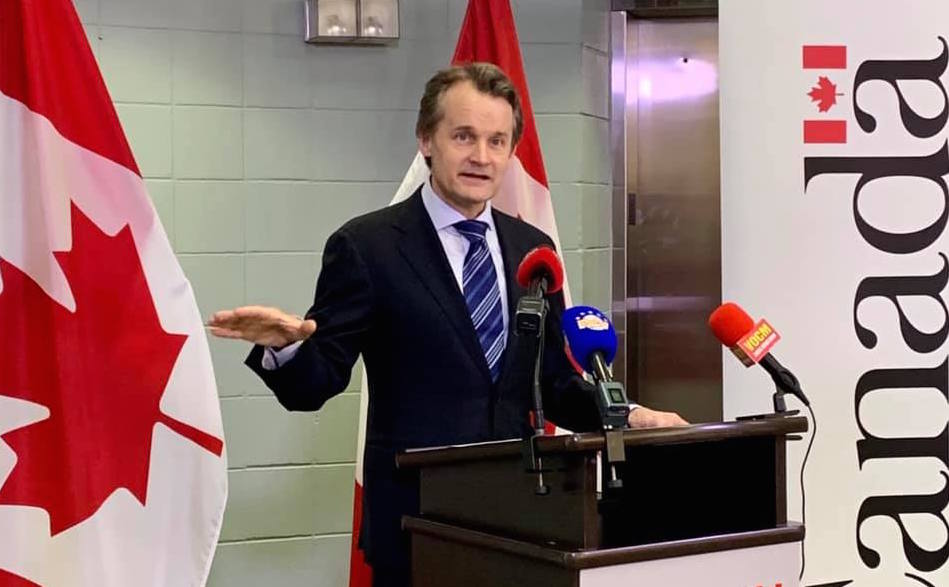Across Canada, environmentalists and First Nations will be closely watching the April 19 release of the federal budget to see just how far the Trudeau Liberals will go in their push for small modular reactors (SMRs).
In September 2020, Canada’s Minister of Natural Resources Seamus O’Regan endorsed SMRs and stated that there is “no pathway to net zero [carbon emissions] without nuclear,” which prompted David Suzuki to famously tell the CBC: “I want to puke.”
Apparently, many share that feeling.
More than 100 Indigenous and civil society groups across Canada are now opposed to the new nuclear reactors, which are being pushed by the federal government and four provinces — Saskatchewan, Ontario, New Brunswick and Alberta — as so-called “clean energy” and a supposed solution to climate change.
These governments argue that the reactors would be the replacement for diesel in remote communities and for use in off-grid mining, tar-sands development, heavy industry, and as exportable expertise in a global market.
But opponents call SMRs “dirty, dangerous and distracting” from real climate solutions.
Even before the budget, the Trudeau Liberals have already taken several steps to advance development of the reactors, especially for use in off-grid mining.
Steps towards small reactors
The feds endorsed the March 2019 Canadian Minerals and Metals Plan, drawn up by federal, provincial and territorial governments. That plan urges governments to “accelerate efforts to develop and adopt clean energy sources, especially for northern, remote and isolated communities that rely on diesel” and “continue to study the feasibility of small modular reactors in mining operations, as well as the potential market for this technology.”
Then, in September 2020, Canada and the U.S. agreed to collaborate on the financing and production of rare-earth and other key metals, which are necessary for a wide range of products including batteries, solar panels, electric vehicles, AI, and weaponry.
After the December 2020 release of the “SMR Action Plan,” the federal government also decided that there would be no environmental impact assessments for small modular reactors, and that tax incentives should be given for this so-called “clean technology.”
The recent mandate letter to Finance Minister Chrystia Freeland directs her to “cut tax rates by 50 per cent for companies that develop and manufacture zero-emission technology” in order to “make Canada a world leader in clean technology.”
In an important and astonishing move, as of January 2021, the Canadian government is allowing the abandonment of nuclear reactors and other nuclear waste at remote sites.
As rabble.ca noted, “[t]he Canadian Nuclear Safety Commission (CNSC) has just given a green light to the preferred industry solution for disposal of nuclear reactors — entomb and abandon them in place, also known as ‘in-situ decommissioning.’ This paves the way for the introduction of a new generation of ‘small modular’ nuclear reactors or SMRs.”
While this would be a disaster for the environment and nearby communities, it would be a boon for the nuclear industry and the off-grid mining sector, which would not have to deal with the fallout and repercussions of such nuclear waste once a mining project is finished.
Important policy change
On December 7, 2020 the Hill Times published an open letter to Treasury Board from more than 100 women leaders across Canada, stating:
“We urge you to say ‘no’ to the nuclear industry that is asking for billions of dollars in taxpayer funds to subsidize a dangerous, highly polluting and expensive technology that we don’t need. Instead, put money into renewable, energy efficiency and energy conservation.”
In her fall economic statement, Finance Minister Freeland had touted small modular reactors and noted that “targeted action by the government to mobilize private capital will better position Canadian firms to bring their technologies to market.” That suggested that the Canada Infrastructure Bank would be using some of its $35 billion to finance new nuclear reactors.
It’s crucial to highlight a recent change of policy at the infrastructure bank.
In its first four years, the bank had to submit a list of recommended projects for financing to the infrastructure minister, and then the minister had to send that list to Treasury Board for approval. But the current minister, Catherine McKenna, is making changes.
“McKenna said she’s close to signing off on a far more efficient process. The infrastructure bank would be given written instructions of the kinds of investment the government expects, and then the board of directors and chief executive [CEO and chair] will decide on their own how to deploy the money.”
While this might be “efficient,” it’s important to note that the infrastructure bank’s board of directors is entirely corporate in its membership.
What does it mean to give so much power to the board? One thing it means is that an appeal to Treasury (such as the one cited above) would fall on deaf ears, since the Treasury Board has been cut out of the deciding process on infrastructure bank project financing.
As we shall see, this situation will benefit off-grid mining and one company in particular.
This is part one of a two-part series on small modular reactors. Watch for part two next week.
Freelance writer Joyce Nelson is the author of seven books. She can be reached via www.joycenelson.ca.
Image credit: Seamus O’Regan/Facebook



